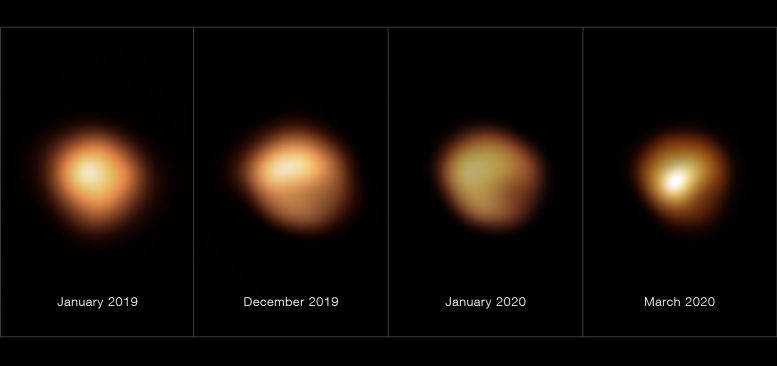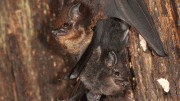
These images show the surface of the red supergiant star Betelgeuse during its unprecedented dimming, which happened in late 2019 and early 2020. The image on the far left, taken in January 2019, shows the star at its normal brightness, while the remaining images, from December 2019, January 2020, and March 2020, were all taken when the star’s brightness had noticeably dropped, especially in its southern region. Credit: ESO/M. Montargès et al.
The star Betelgeuse became visibly darker in 2019 and 2020, puzzling astronomers; new images show that the star was partially concealed by a cloud of dust, solving the mystery of the ‘Great Dimming’ of Betelgeuse.
When Betelgeuse, a bright orange star in the constellation of Orion, lost more than two-thirds of its brightness in late 2019 and early 2020, astronomers were puzzled.
What could cause such an abrupt dimming?
Now, in a new paper published in Nature, an international team of astronomers reveal two never-before-seen images of the mysterious darkening — and an explanation. The dimming was caused by a dusty veil shading the star, which resulted from a drop in temperature on Betelgeuse’s stellar surface.
This animation combines four real images of the red supergiant star Betelgeuse, the first taken in January 2019 and the others taken in December 2019, January 2020 and March 2020 during the star’s unprecedented dimming. All images, which allow us to resolve the surface of the star, were taken with the SPHERE instrument on ESO’s Very Large Telescope. Credit: ESO/M. Montargès et al./L. Calçada
Led by Miguel Montargès at the Observatoire de Paris, the new images were taken in January and March of 2020 using the European Southern Observatory’s Very Large Telescope. Combined with images previously taken in January and December 2019, the astronomers clearly capture how the stellar surface changed and darkened over time, especially in the southern region.
“For once, we were seeing the appearance of a star changing in real-time on a scale of weeks,” Montargès says.
According to the astronomers, this abrupt dimming was caused by the formation of stardust.
Betelgeuse’s surface regularly changes as giant bubbles of gas move, shrink, and swell within the star. The team concludes that some time before the great dimming, the star ejected a large gas bubble that moved away from it, aided by the star’s outward pulsation. When a patch of the surface cooled down shortly after, that temperature decrease was enough for the heavier elements (e.g. silicon) in the gas to condense into solid dust.
When Betelgeuse, a bright orange star in the constellation of Orion, became visibly darker in late 2019 and early 2020, the astronomy community was puzzled. A team of astronomers have now published new research done with ESO’s Very Large Telescope and Very Large Telescope interferometer that solves the mystery of Betelgeuse’s dimming. This video summarizes the discovery. Credit: ESO
The new findings match Andrea Dupree’s previous observations of Betelgeuse using the Hubble Space Telescope. Dupree, an astronomer at the Center for Astrophysics | Harvard & Smithsonian and a co-author on the new paper, captured signs of dense, heated material moving through the star’s atmosphere in the months leading up to the great dimming.
“With Hubble, we could see the material as it left the star’s surface and moved out through the atmosphere, before the dust formed that caused the star to appear to dim,” Dupree says.
Dupree found that the material moved about 200,000 miles per hour as it traveled from the star’s surface to its outer atmosphere. Once the gas bubble was millions of miles from the hot star, it cooled and formed a dust cloud that temporarily blocked the star’s light.
The star returned to its normal brightness by April 2020.
Dupree, who has been studying Betelgeuse since 1985, hopes to continue studying the star in hopes of catching it eject another gas bubble.
“Betelgeuse is a unique star; it is enormous and nearby and we are observing material directly leaving the surface of the supergiant,” she says. “How and where material is ejected affects our understanding of the evolution of all stars!”
For more on this research, read Astronomers Were Puzzled by “Great Dimming” of Betelgeuse – Now the Mystery Is Solved.
Reference: “A dusty veil shading Betelgeuse during its Great Dimming” by M. Montargès, E. Cannon, E. Lagadec, A. de Koter, P. Kervella, J. Sanchez-Bermudez, C. Paladini, F. Cantalloube, L. Decin, P. Scicluna, K. Kravchenko, A. K. Dupree, S. Ridgway, M. Wittkowski, N. Anugu, R. Norris, G. Rau, G. Perrin, A. Chiavassa, S. Kraus, J. D. Monnier, F. Millour, J.-B. Le Bouquin, X. Haubois, B. Lopez, P. Stee and W. Danchi, 16 June 2021, Nature.
DOI: 10.1038/s41586-021-03546-8









Be the first to comment on "Mystery Solved: Astronomers Unravel the Puzzle of Betelgeuse’s “Great Dimming”"